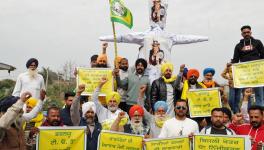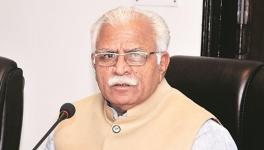Elite Despair About “Farmers’ Lack of Discipline” is Comical, Though Not Innocent

A small section of protesters barging into the Red Fort on Republic Day has been used by the right-wing, the corporate media, and “liberal” champions of pro-corporate economic policies to attack the farmers’ agitation currently underway in India. This is an occasion when all those who are concerned about the lives of the working people should stand guard against turning the country’s attention away from the demand of the farmers – repeal the three anti-farmer laws that the Bharatiya Janata Party got passed in September 2020.
The massive Tractor Parade on Republic Day sent out a powerful message to the ruling oligarchy in India which is trying to profiteer at the expense of the country’s farmers and workers. The protesting farmers were warmly welcomed by the people of Delhi. But this reality was too much for the ruling classes to stomach, and their minions in the corporate media have dutifully pounced upon stray incidents to discredit the farmers’ agitation.
Anybody who has been part of mass agitations knows that such agitations are inherently disruptive. The whole point about a mass agitation demanding something from authorities in power is to force the authorities to accept the demands of the agitators (yes, that's a truism, but it has to be stated). How do the agitators achieve this?
If the authorities value democratic opinion, they might be forced to accept the agitators' demands if they believe that those demands are supported by a substantial section of the population whose support is sought by the authorities themselves. If the authorities do not value democratic opinion, they might be forced to accept the agitators' demands if they come to the conclusion that the agitation is turning out to be too costly or difficult to ignore, manage or suppress. Often the reason for the authorities accepting protesters’ demands would be some combination of the two cases described above.
Also read: Republic Day: Farmers’ Storm Capital, Big Protests Across Country
For a long time, the central government of India has found it pretty easy to turn its back on mass agitations of the peasants and workers in India. If an agitation demanding something from the central government takes place in some state or a few states alone, they can often be ignored. A good example is the struggle in Kerala against the India-ASEAN Free Trade Agreement which was signed in the year 2009. Hundreds of thousands of people participated in the struggle. Mass campaigns to politically educate the people were undertaken. A human chain was organised by the Communist Party of India (Marxist) [CPI(M)] from the north to the south of the state. But what happened? The central government looked the other way and went ahead to sign the agreement. The so-called "national media" (most of them truly abominable corporate media outlets) is mostly careful to avoid giving substantial coverage to such protests, except when noise on the social media makes it impossible for the news to be brushed under the carpet.
What happens when an agitation takes place in Delhi? The government stipulates that the protest should take place in some designated spots (mainly Jantar Mantar and Ram Lila Maidan). So the media would ignore the agitation, the general public - who usually don't have to go through these spots – wouldn’t even know about the agitation (except through corporate media reports about the "inconvenience" caused by these struggles), and the government can pretend to not know about the agitation.
Agitations are not necessarily confined to designated spots everywhere in India. Again, take the example of Kerala. Many mass protests take place in the major roads in Thiruvananthapuram, the capital city. Often they take place right in front of the Secretariat, the seat of the state government. Therefore, mass agitations are in the public eye. They do cause some inconvenience to the public – which is all the more reason for them to be concerned about the demands of the agitators.
But in Delhi, the centre of State power in India, protests are mostly confined to sanitised spaces which makes it easy for the central government to ignore the protests.
Also read: Live Blog: Lakhs of Farmers Waiting at Delhi Borders, Govt. Scrambling for Control
Now, let us return to the present farmers' agitation. In the beginning, the protests took place in various states, with the most powerful protests taking place in Punjab and Haryana. But the central government found it easy to avoid paying heed. Reporting on the protests in media outlets with reach across India was scant, which meant that the people in the country were mostly unaware of the ongoing struggle.
Then the farmers took the next step, of marching to Delhi to bring the issue to the limelight. (One point to note here is the issue of distance. The organised farmers' movement is powerful in several states like Kerala and West Bengal, but farmers from those states would find it difficult to travel to Delhi in large numbers to stage an agitation for several weeks or months. The situation of the farmers of Punjab and Haryana is much better in this regard. With adequate planning, mobilisation of resources, and mass campaigns, they made the march to Delhi a reality.)
Right at the beginning, the agitating farmers had to make a choice regarding where to stage the protest. The central government and the Delhi Police under its control wanted to keep the protesters in some corner of Delhi where they will be away from public attention. Then the government can carry on its usual tactic of brushing the agitation aside. Some "leaders" with big social media presence but very little support among farmers were in favour of this, because they tend to be more concerned about not causing "inconvenience" to anybody and about appearing to be “nice guys” for the corporate media.
But, the major farmers' organisations rejected this manoeuvre by the government, and decided to camp at the border areas of Delhi. This enabled them to transport people and resources for the agitation, even as they stayed very much in the public glare. Very much aware that the corporate media would be hostile to them, the farmers also stepped up their efforts to spread information on their own, through the social media and through their own media outlets.
Then came the Kisan Republic Day Parade on January 26. A march to the heart of Delhi itself would have been the best for the farmers, so that they could capture the attention of the public in the most effective manner and put pressure on the government to accept their demands. The government, however, did not agree, and told the farmers to stick to some routes near the border areas within Delhi. Those who have been part of mass agitations know that they are messy. Democracy is a messy affair! If there are large number of organisations involved in an agitation, it can be expected to be messier. But the farmers' struggle has so far been remarkably disciplined and peaceful, even as they have been met with atrocious levels of violence by the police at various points of time.
On January 26, the police unleashed violence on the protesting farmers, firing tear-gas and lathi-charging the protesters. Nevertheless the vast majority of protesters stuck to the pre-decided routes. Some groups of protesters who were stopped by the police took alternative routes and reached central Delhi, and some eventually reached the Red Fort. Did the heavens fall because of this? No, right?
But precisely because it was not an action that was planned by the Samyukta Kisan Morcha (SKM, the coalition of farmers’ organisations which is leading the agitation), this "occupation of the Red Fort" was not sustained. Let us remember that if it was planned that way, millions of marching farmers could not have been stopped by the Delhi Police without high casualties. (The SKM itself says it is trying to get a fuller picture of the events, since there are conflicting versions about the people who led a group to the Red Fort.)
What was most amusing was the reaction of the corporate media anchors, including those working for supposedly "liberal" channels. The horror they expressed at the possibility of farmers entering central Delhi was comical (“What would happen if the farmers enter Lutyens Delhi?”). It was a clear expression of the upper classes' and upper middle classes' fear of the masses entering their "sacred" spaces. The TV anchors were speaking from their hearts, on the basis of their class positions. "The farmers are not supposed to be here," was the cry of one anchor. Really, sir? Where are they supposed to be? Under your jackboot?
There was no horror expressed at the violence by the police that far outstripped unruly action by a few protesters. In some cases, the reporters on the ground criticised police violence, and then the TV anchors tried to justify the police! Sometimes they lamented that "there wasn't enough police force" to stop the farmers, forgetting that the number of police personnel in India pales in front of the number of farmers.
Also read: Farmers Take to Roads Across Country on Republic Day, Several Detained in Gujarat
As always, adventurist action by some elements during protest movements tend to distract from the core issues. Just to be clear, the occupation of the Red Fort would not have been an issue if that indeed was the course of action that the farmers' movement had decided collectively. But in this case it wasn't, and the leaders of the major farmers' organisations have distanced themselves from that action.
All these should not result in us losing perspective. The scale of the mass murder (400,000 farmers' suicides since 1995) that has already taken place as a result of anti-farmer policies and that of the violence of the loss of livelihoods and lives that will result because of the anti-farmer laws, exceed the "violence" or "lack of discipline" of some protesters by light years. If one is more concerned about some protesters reaching central Delhi or Red Fort or about some damage caused to a few buses than about the issues that the protesting farmers are raising, it means he/she is either a politically uneducated person, or somebody who thinks he/she wouldn't be affected by these anti-farmer laws at all.
Those who cannot be convinced by the justness of this struggle will have to be defeated. The choice for those who are not direct participants in the struggle is clear: either stand in solidarity with the farmers' movement, or watch as history rolls over them.
(The writer is an economist and a researcher at Tricontinental: Institute for Social Research. The views are personal.)
Get the latest reports & analysis with people's perspective on Protests, movements & deep analytical videos, discussions of the current affairs in your Telegram app. Subscribe to NewsClick's Telegram channel & get Real-Time updates on stories, as they get published on our website.
























